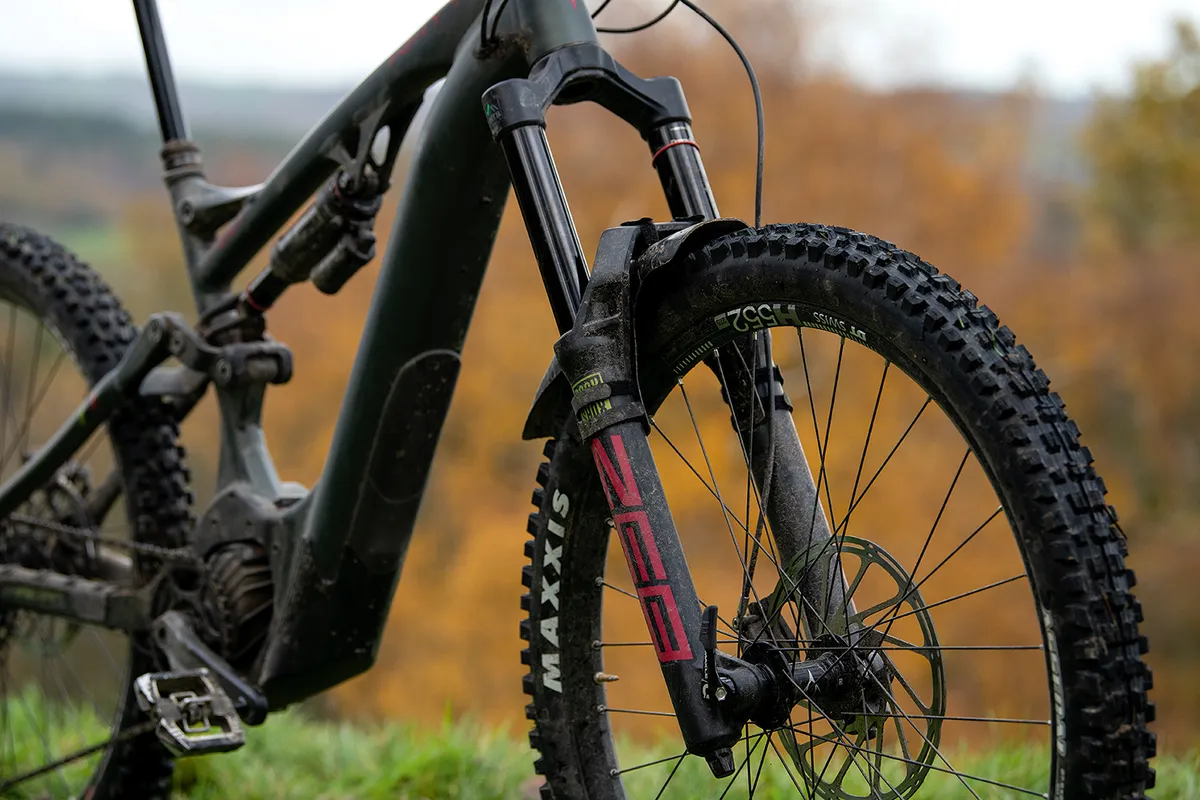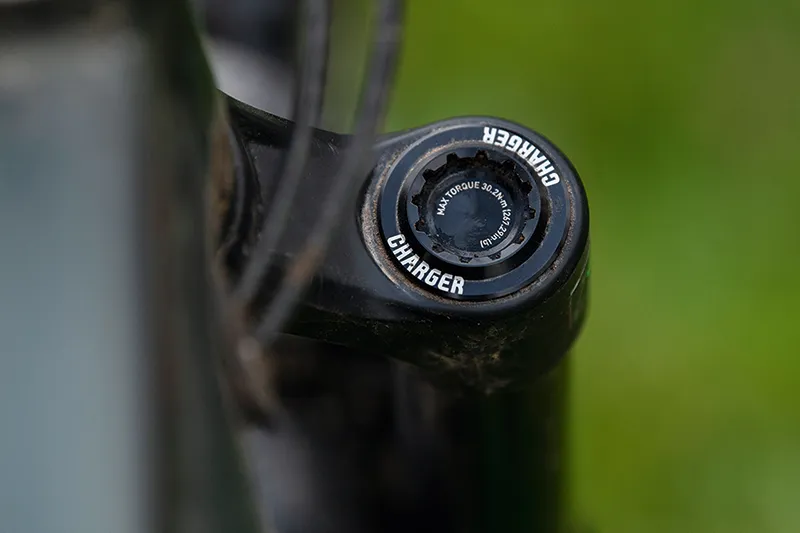Whyte’s E-180 is designed to be a flat-out bruiser of a bike, ready to tackle just about anything you dare to throw it down.
Its solid spec list, latest-generation Bosch motor and modern geometry all look great on paper, but just how does it handle on the trails?
Inside that massive 6061 alloy down tube sits a 625Wh Bosch PowerTube battery. If you want to remove it, it’s a case of releasing the sump guard/battery cover with a T20 Torx key (followed by the anchor bolt) and then carefully sliding it out of the frame.
It’s this big power pack that gives life to the impressive fourth-generation Bosch Performance Line CX motor, which boasts 85Nm of max torque, up to 340 per cent assistance and four modes, including the impressive eMTB setting, which automatically changes modes based on things such as the pitch of the bike and your pedalling input.
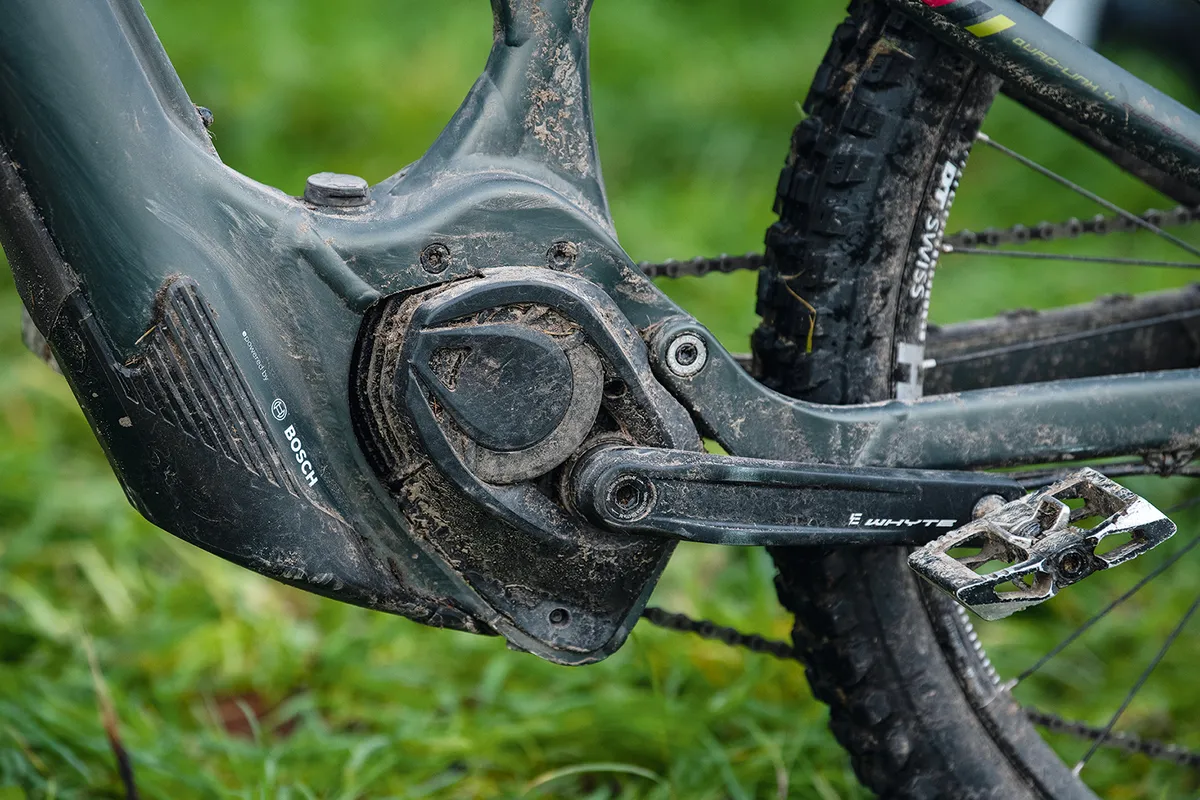
Whyte E-180 S V2 geometry
Designed around 650b wheels, the E-180 sports some decent geometry numbers.
A slack 63.9-degree head angle adds stability for when things get rowdy, while a 75.5-degree seat tube angle keeps the rider well-positioned for efficient climbing.
I opted for the medium (there are large and extra-large sizes too), which sports a healthy 455mm reach. At the rear, 444mm chainstays promise to help deliver a balanced ride.
One number that's of significant interest is the bottom bracket height. It sits just 333mm from the ground – very low, when you consider that there’s 170mm of rear-wheel travel on tap (controlled by a RockShox Super Deluxe Select rear shock) and that this type of bike is designed to clamber over some pretty awkward terrain.
| | M | L | XL |
|---|---|---|---|
| Seat angle (degrees) | 75.5 | 75.3 | 75.1 |
| Head angle (degrees) | 64 | 64 | 64 |
| Chainstay (cm) | 44.4 | 44.4 | 44.4 |
| Seat tube (cm) | 43.18 | 45.72 | 48.25 |
| Top tube (cm) | 60.5 | 63.3 | 66.3 |
| Head tube (cm) | 12 | 13 | 14.5 |
| Bottom bracket height (cm) | 33.5 | 33.5 | 33.5 |
| Wheelbase (mm) | 1,241 | 1,270 | 1,302 |
| Standover (cm) | 84.1 | 84.1 | 84.1 |
| Stack (cm) | 62.63 | 63.52 | 64.87 |
| Reach (cm) | 45.5 | 48 | 50.5 |
Whyte E-180 S V2 kit
Whyte has fitted the most basic RockShox ZEB fork on the S V2, which uses the Charger R damper, not the pricier Charger 2.1 RC found in the Ultimate and Select+ models.
There’s no external compression damping adjustment, but you can alter the rebound speed and add/remove volume spacers to/from the air spring to alter how the fork behaves later in its 180mm of travel.
SRAM provides its Code R brakes, which clamp onto a massive 220mm rotor at the front and a 200mm disc at the rear. It also provides the GX Eagle gearing, which I’ve had few issues with in the past, but struggled to get the shifts indexed correctly on the E-180.
Whyte’s own-brand dropper can be adjusted between 140 and 170mm of travel (on the medium and large bikes), and works well, although the remote lever did get a little spongy and stiff after heavy use in the mud.
DT Swiss ebike rims are shod with Maxxis Assegai tyres, in a 2.5in width and the 3C MaxxTerra compound, which offer loads of traction.
Wisely, Whyte has opted for a reinforced EXO+ casing at the front and even tougher Double Down sidewalls at the rear.
Whyte E-180 S V2 first ride impressions
I spent the majority of my time on the Whyte in Bosch’s eMTB setting, where the motor transitions almost seamlessly between modes based on what assistance it feels you require.
Push on the pedals and the help dished out is punchy but subtle enough and easy to control, even when pulling a wheelie. It helps that the E-180’s geometry makes you feel right at home almost instantly.
With a balanced feel and dimensions, it’s easy to acclimatise to, so you can ride confidently from the get-go. During my winter test rides, I was averaging around 35km and 1,100 to 1,200m of climbing between battery charges, when toggling between the motor’s eMTB and Turbo modes.
On the climbs, the E-180 feels well-proportioned, and roomy enough when seated to ensure that things remain comfortable during lengthy drags. Get into more technical uphill terrain and the grippy tyres, incredibly supple suspension and easy-to-control power make cleaning tricky obstacles or steep sections straightforward.
It helps that the assistance doesn’t cut out completely or immediately when you do stop pedalling, so those awkward manoeuvres that require you to do a quick half crank or stop pedalling momentarily while lifting the rear wheel up and over an obstacle feel more natural and easy to execute.
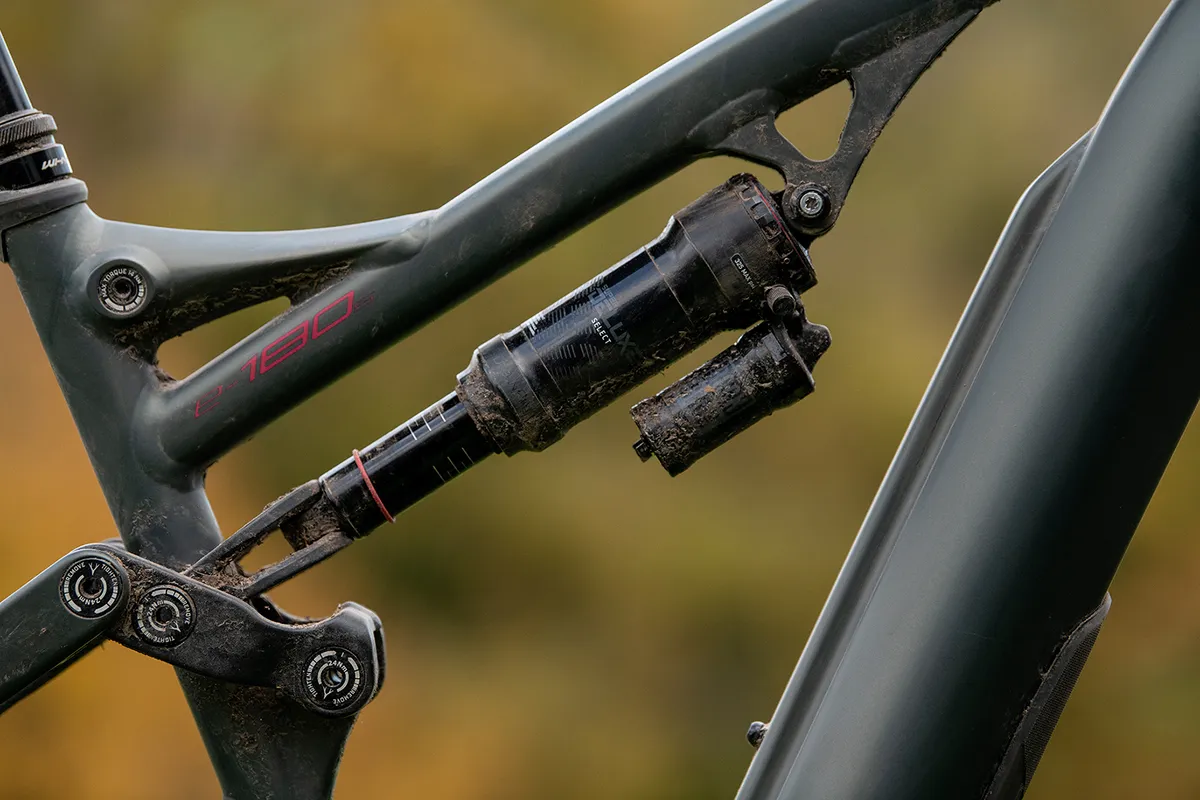
Wind up the E-180 and hammer into faster, mellower trails where you exceed the speed limit of the motor, and you soon notice the weight of the bike and just how eager the suspension is to track the terrain, which makes it harder – but not impossible – to throw around.
The impressive geometry still means it can be lofted and bounced around the trail, but it takes some effort from the rider. Where the E-180 really comes into its own and shines compared to its competitors is when the going gets steep.
The low-slung chassis, stable geometry and the traction generated from the tyres and suspension make this bike rip around corners with incredible speed and composure.
In deep, rutted sections of trail, there were times when I clipped a pedal here and there, but for the most part I really appreciated the Whyte’s low centre of gravity and the handling it helps to produce.
In rougher terrain, the frame feels taut and stiff, but not uncomfortably so. The RockShox dampers help boost comfort, yet ensure there’s still enough support to keep things feeling relatively reactive when you want to load the bike through the turns or up the take-off of a jump.
If it were down to me, I’d boost the rear brake rotor size to 220mm because when you do start to get tired, it feels like you need all the stopping power possible to bring this hefty speed machine to a halt. Still, this is an easy fix that won’t cost much money.
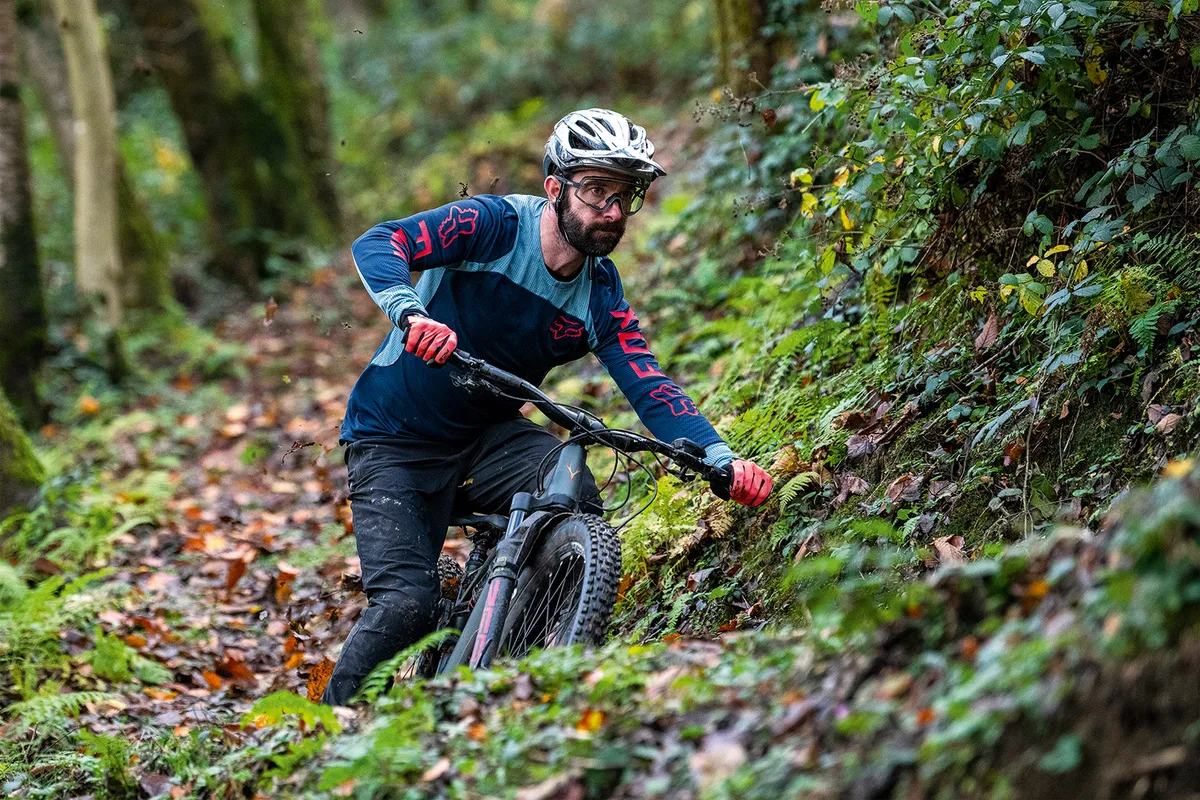
On the whole, the E-180 is a great long-travel e-MTB that’s more than at home sliding its way down steep hillsides before quickly getting you back to the top for another go.
There’s a shorter-travel version too (Whyte E-160 or E-150 29er), which uses the same motor and has similarly progressive geometry, if this looks like a little too much bike for you.
Whyte E-180 S V2 early verdict
A downhill bomber of a bike that’s best suited to steeper trails but is no slouch at getting back up.
Product
| Brand | whyte |
| Price | 5500.00 GBP |
| Weight | 25.3000, KILOGRAM (M) - without pedals |
Features
| Fork | RockShox ZEB, 180mm (7.1in) travel |
| br_stem | Whyte Enduro 35, 35mm |
| br_chain | SRAM GX Eagle |
| br_frame | 6061-T6 aluminium alloy, 170mm (6.7in) travel |
| br_motor | Bosch Performance Line CX (Gen 4) with 625Wh Bosch PowerTube battery |
| Tyres | Maxxis Assegai EXO+ (f) and DD (r) 3C MaxxTerra 27.5x2.5in |
| br_brakes | SRAM Code R, 220mm/200mm rotors |
| br_cranks | Whyte, forged alloy |
| br_saddle | Whyte |
| br_wheels | DT Swiss Hybrid 30 rims on alloy hub |
| br_shifter | SRAM GX Eagle, 12spd |
| br_cassette | SRAM Eagle 11-50 |
| br_seatpost | Whyte drop.it 140-170mm dropper |
| br_handlebar | Whyte, 800mm |
| br_rearShock | RockShox Super Deluxe Select |
| br_availableSizes | M, L, XL |
| br_rearDerailleur | SRAM GX Eagle |
